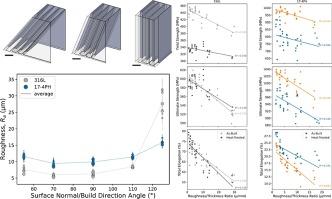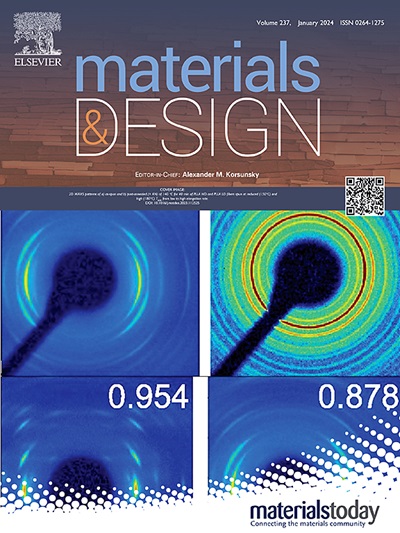Evaluating the impacts of surface roughness and microstructure on the size effect in two additively manufactured stainless steels
IF 7.6
2区 材料科学
Q1 MATERIALS SCIENCE, MULTIDISCIPLINARY
引用次数: 0
Abstract
Laser powder bed fusion (L-PBF) enables direct manufacturing of components with complex geometries and thin walls, but many authors report size-dependent mechanical properties that may complicate design. Size effects are commonly attributed to surface roughness, microstructure, and/or internal defects, but the relative importance of each is still not fully understood. To systematically study these effects, L-PBF specimens made of two microstructurally-distinct stainless steels (17-4PH and 316L) were manufactured and mechanically tested, in varied heat-treatment conditions and across a range of thicknesses and build angles. It was found that the size-dependent mechanical properties are efficiently predicted by the ratio of surface roughness to specimen thickness, , in a way that is relatively microstructure-agnostic. This metric is particularly useful for predicting ultimate strength and elongation, while microstructure moderates its predictive power for yield strength, especially in the more processing-sensitive 17-4PH. When considered in isolation, thickness or surface roughness had weaker correlations with mechanical properties and, importantly, tended to correlate much more strongly with one steel's properties than the other's. Comparing this comprehensive dataset with summary data from other researchers highlights the utility of , and provides semi-quantitative estimates of the relative impacts of porosity, microstructure, and on size-dependent properties.

评估表面粗糙度和微观结构对两种快速成型不锈钢尺寸效应的影响
激光粉末床熔融(L-PBF)可直接制造具有复杂几何形状和薄壁的部件,但许多学者报告说,尺寸与机械性能有关,可能会使设计复杂化。尺寸效应通常归因于表面粗糙度、微观结构和/或内部缺陷,但对每种效应的相对重要性尚不完全了解。为了系统地研究这些效应,我们制造了由两种微观结构不同的不锈钢(17-4PH 和 316L)制成的 L-PBF 试样,并在不同的热处理条件下、在一定的厚度和构建角度范围内进行了机械测试。结果发现,表面粗糙度与试样厚度之比 Ra/t 可以有效地预测与尺寸相关的机械性能,而且与微观结构相对无关。该指标尤其适用于预测极限强度和伸长率,而微观结构则会降低其对屈服强度的预测能力,尤其是对加工更为敏感的 17-4PH 材料。如果单独考虑,厚度或表面粗糙度与机械性能的相关性较弱,重要的是,它们与一种钢材性能的相关性往往比与另一种钢材性能的相关性更强。将这一综合数据集与其他研究人员的汇总数据进行比较,突出了 Ra/t 的实用性,并提供了孔隙率、微观结构和 Ra/t 对尺寸相关性能的相对影响的半定量估计。
本文章由计算机程序翻译,如有差异,请以英文原文为准。
求助全文
约1分钟内获得全文
求助全文
来源期刊

Materials & Design
Engineering-Mechanical Engineering
CiteScore
14.30
自引率
7.10%
发文量
1028
审稿时长
85 days
期刊介绍:
Materials and Design is a multi-disciplinary journal that publishes original research reports, review articles, and express communications. The journal focuses on studying the structure and properties of inorganic and organic materials, advancements in synthesis, processing, characterization, and testing, the design of materials and engineering systems, and their applications in technology. It aims to bring together various aspects of materials science, engineering, physics, and chemistry.
The journal explores themes ranging from materials to design and aims to reveal the connections between natural and artificial materials, as well as experiment and modeling. Manuscripts submitted to Materials and Design should contain elements of discovery and surprise, as they often contribute new insights into the architecture and function of matter.
 求助内容:
求助内容: 应助结果提醒方式:
应助结果提醒方式:


